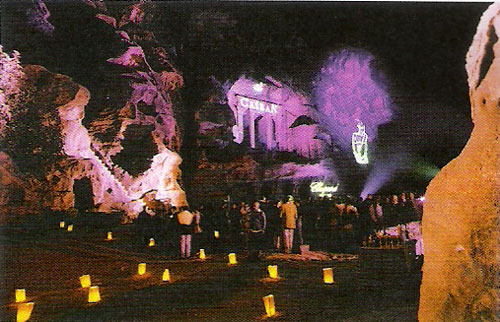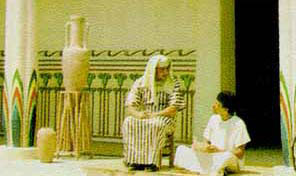Hidden behind an almost impenetrable barrier of rugged mountains, the rock-carved city of Petra is full of mysterious charm. The approach through the cool gloom of the Siq, a long narrow gorge whose steeply rising sides all but obliterate the sun, provides a dramatic contrast with the magic to come. Suddenly the gorge opens into a natural square dominated by Petra's most famous monument, the Khasneh, whose intricately carved facade glows in the dazzling sun.
More facades beckon the visitor on until the ancient city gradually unfolds, one monument leading to the next for kilometer after kilometer. The sheer size of the city and the quality of beautifully carved facades is staggering and leads one to reflect on the creativity and industry of the Nabateans who made Petra their capital more than 2,000 years ago. From their capital at Petra the Nabateans had established an elaborate network of caravan routes which brought spices, incense, myrrh, gold, silver and precious stones from India and Arabia, to be traded onto the west.
From the wealth they acquired, they adorned their city with palaces, temples and arches. Many that were freestanding have largely disappeared but many were carved into the rock i.e. the treasury, the monumental tombs and the high place of sacrifice. These still remain today in a condition of perfection so staggering that you feel you must have entered a time wrap. Petra is an enchanting place that captivates and excites the senses. Its overwhelming size, rich textures and stunning surroundings create an ambiance almost impossible to describe.
As you set off from the City's entrance gate, at this stage the valley is quite wide and open. This section is the approach to the narrow gorge and is know as Bab Es-Siq, gateway of the Siq. The first monuments you pass are the curious Djinn Blocks, a cluster of three freestanding rock cubes just to the right of the track.
Continuing along the path you come to the Obelisk Tomb, carved out of the cliff. At one point the passageway goes from a wide breach to a dark chasm not more than a few feet across. Suddenly in the space of a few footsteps, you get your first glimpse of Petra's most fabled achievement, El-Khazneh (the Treasury), which looms up in the brilliant sunshine, carved from the rock, defiled by man.
At the outer siq's widest point a gully runs abruptly off to the south. The path takes you to the high place: an ancient Nabatean sacrificial site with an Altar cut from the rock. For those who can stand the strenuous climb, the sweeping view of Petra is well worthwhile.
Past the altar the track continues leading to the garden Tridinium (the garden temple complex). There are two freestanding colonnades, in front of which are a remnants of a shrine. Continuing on, one passes dozens of wall niches, before arriving at the Roman Soldier's Tomb, and a further Triclinium.
Petra has dozens of sacred sites. On a windswept ridge high above the city, the Nabatean people extolled their gods at the High Place known as El-Madbah in Arabic. In an area known as the street of facades, many classical Nabatean ruins can be seen.
The Outer siq makes a sudden turn northwards and leads to the Roman Theatre which was built in typical Roman style. The substantial building Qasr El Bint Faroun (Palace of the Pharoa's daughter'), demonstrates that the Nabateans were capable of creating freestanding buildings.
Petra's second most spectacular construction after the treasury is El-Deir (The Monastery). For a feeling of Petra's immensity and the sheer power of the rock, the trip is essential.
Across from the Qasr El Bint a jumbo of steps lead up to Petra's Museum. The room housing the small collection is the most monumental exhibit of all.






